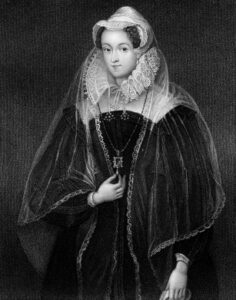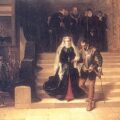
On this day in history, 14th October 1586, the trial of Mary Queen of Scots began at Fotheringhay Castle in Northamptonshire. Historian John Guy, author of “My Heart is My Own: The Life of Mary Queen of Scots”, has written a brilliant chapter on Mary’s downfall, “Nemesis”, and I have him to thank for the information in this article.
Mary Queen of Scots had, at first, refused to appear before Elizabeth I’s commission, but had been told by William Cecil that the trial would take place with or without her. She appeared in front of the commission at 9am, dressed in a black velvet gown and a white cambric cap and veil. Mary then protested against the commission, arguing that the court was not legitimate and arguing against the fact that she was not allowed legal defence and was not able to call any witnesses. Mary was also not permitted to examine any of the documents being used against her. Her protests were in vain and the prosecution went ahead and opened the trial with an account of the Babington Plot, arguing that Mary knew of the plot, had given it her approval, agreed with it and had promised to help. Mary protested her innocence:-
“Mary: I knew not Babington. I never received any letters from him, nor wrote any to him. I never plotted the destruction of the Queen. If you want to prove it, then produce my letters signed with my own hand.
Counsel: But we have evidence of letters between you and Babington.
Mary: If so, why do you not produce them? I have the right to demand to see the originals and copies side by side. It is quite possible that my ciphers have been tampered with by my enemies. I cannot reply to this accusation without full knowledge. Until then, I must content myself with affirming solemnly that I am not guilty of the crimes imputed to me…”1
Unfortunately for Mary, Elizabeth’s spymaster, Sir Francis Walsingham, had collected a great deal of evidence:-
- A confession made by Sir Anthony Babington who had also pleaded guilty at his own trial.
- A deciphered transcript in English of Mary’s reply to Babington.
- A reciphered copy of Mary’s original letter to Babington which looked exactly like the original.
- Confessions from Mary’s secretaries.
When the prosecution produced all of this evidence, Mary burst into tears but still denied her involvement, claiming that the documents were counterfeit. Walsingham proclaimed his innocence, stating that the documents were real. A distraught Mary proclaimed that “I would never make shipwreck of my soul by conspiring the destruction of my dearest sister.”2 The court was then adjourned for lunch.
After lunch, the secretaries’ confessions were read out, much to Mary’s shock and horror. Mary argued that her letters must have been tampered with after she had seen them, and then argued:-
“The majesty and safety of all princes falleth to the ground if they depend upon the writings and testimony of their secretaries… I am not to be convicted except by mine own word or writing.”3
The trial continued the next day with the prosecution accusing Mary of consenting to Elizabeth’s assassination in her reply to Babington. Mary tried to argue that although she had written “then shall it be time to set the gentlemen to work taking order upon the accomplishing of their design”4, she had not specified what the “work” was. However, as the prosecution pointed out, Mary had also appealed for foreign help and although she argued that an act of war, even if it resulted in Elizabeth’s death, was legitimate if it allowed her, a queen, to be free at last, the commission saw her actions as an act of treason.
As the trial closed, Mary demanded that she should be heard in front of Parliament or the Queen, but she was fighting a losing battle. Sentence was delayed as long as possible, by order of Elizabeth, but on the 25th October the commission reconvened and found Mary guilty. On he 29th October, Parliament met to discuss Mary Queen of Scots, the Babington Plot and her role in Lord Darnley’s murder, and it was decided that they should petition Elizabeth to execute Mary. This put Elizabeth in a difficult position as she did not want to be accused of regicide. On the 4th December, Mary was publicly proclaimed guilty and finally, on the 1st February 1587, Elizabeth called her secretary, William Davison, asking him to bring Mary’s execution warrant to her to sign. Elizabeth signed it but told Davison to ask Walsingham to write to Sir Amyas Paulet, in his own name, asking him to kill Mary. This would enable Elizabeth to be rid of her nemesis without taking any responsibility for it, instead Paulet would be acting privately under the Bond of Association*. Paulet was understandably horrified, protesting that “God forbid that I should make so foul a shipwreck of my conscience.”5 Meanwhile, Sir William Cecil called a secret meeting of Elizabeth’s Privy Council which agreed to send the signed warant to Fotheringhay. Cecil appointed the Earls of Shrewsbury and Kent to direct the execution and the council agreed to keep Elizabeth in the dark until the deed was done.
On the 8th February 1587 Mary Queen of Scots was executed at Fotheringhay Castle. Although Elizabeth was furious with her Council, so much so that Cecil fled to his home and Davison was thrown into the Tower, John Guy points out that whatever happened to Mary, whether she was assassinated or executed, Elizabeth could deny any responsibility:-
“She had carefully contrived things so that she would win whatever happened. If Mary was killed under the Bond of Association, Elizabeth could disclaim responsibility. If Cecil covertly sealed the warrant and sent it to Fotheringhay behind her back, she could claim she had been the victim of a court conspiracy.”6
Clever!
* The Bond of Association – p474 John Guy describes the Bond of Association as “a licence to kill”. Anyone signing the Bond, which was drawn up by Cecil and Walsingham in 1584 after the 1583 Throckmorton plot, was swearing to “pursue as well by force of arms as by all other means of revenge” anyone plotting to cause harm to the Queen.
Notes and Sources
- My Heart is My Own: The Life of Mary Queen of Scots, John Guy, p490.
- Ibid., p492
- Ibid.
- Ibid., p483
- Ibid., p496
- Ibid., p497
Further Reading
- State trials of Mary, Queen of Scots, Sir Walter Raleigh, and Captain William Kidd, Condensed and copied from the state trials of Francis Hargrave, esq., London, 1776, and of T. B. Howell, London, 1816, with explanatory notes, p1-57







Best. Debate. Ever.
Lovely! I just came across The Elizabeth Files and I must say this has been a most interesting read. I concur with Kristine – Best. Debate. Ever.
Iv just seen these posts as I don’t look on the Elizabeth files much, iv read Frasers book on Mary Queen Of Scots and found it very enjoyable whilst feeling sorry for Mary it’s obvious that she did become involved in the plot to assassinate Elizabeth, but she had been a prisoner for twenty years and I suppose she thought that was the only way she could be free, she did say to Babington she leaves the murder of Elizabeth to his conscience so she’s not quite condoning it but not really condemning it either, her whole life was rather like a soap opera and she arouses fierce debate like Anne Boleyn does, did she agree to the murder of Darnley we will never know, there are the Casket Letters but were they written by her? Like Anne and her alleged adultery it’s a mystery Scotland wasn’t an easy country for a man to rule let alone a woman brought up in France where all she had to do was dance and sing, she was unprepared for the harsh land she had to return to after her mother died, she seemed to court disaster as she fell headlong into a disastrous marriage then whilst pregnant her secretary was murdered in front of her, then Darnley was blown up, abduction by Bothwell and then the uprising against her and her eventual bid for freedom which led to her racing over the border instead of sailing to France where she would have been welcomed with open arms, all these actions are those of a reckless impulsive woman who wasn’t really fit to be Queen, however she was said to be very brave and I believe she was, her fault was that she let her heart rule her head, and put her trust in Elizabeth instead of France, as Fraser said, it was unthinkable for Protestant Elizabeth to take up arms against Scotland on behalf of her Catholic Cousin, this was the politics of the day, whilst feeling sorry for Mary she did bring a lot of her troubles on herself, incidentally Anthony Babington married Margery Draycott a relative of mine, I would just like to add that Michael bloke seems a bit of a nut, ranting and raving like that.
I got involved in history again,now I have retired,but I wanted to approach it from the working persons point of view,to understand their take on it.I have found out lots of what we were taught at school in the 50-60s was incorrect,but probably that’s all they knew then.I bet the working Peasant only knew a quarter of what was going on in the upper classes ,if that much.They were so caught up in trying to get food for tomorrow and surviving ,that this was another world away for them.Henry 8th had,in Hampton Court, 200 workers,in the kitchens alone.I am suprised another Wat Tyler never raised their head,as it must have been dreadful for the workers seeing all this different life style.I think the workers never gave a toss who was head of the Church or who was in power,as long as not another of their children died or their partner never got ill,so no food was coming in.Perhaps things don’t change much..
A large portion of my dissertation is Mary and the catholic threat to the Elizabethan settlement and so I have been reading a lot in to this for months now.
Though a part of me will always in a way pity Mary, I have to agree in that she sealed her own fate. Though Mary was framed by Walsingham, Mary was more than happy to involve herself in the dealings of the Ridolphi, Babbington and Throckmorton plots.
She did have a difficult life, that much is clear, though Mary did not make the right decisions and allowed herself to be embroiled in plots that were always going to lead to her execution. Mary tempted fate,which for a while was on her side in that she wasn’t executed sooner.Despite the “dirty dealings” of Walsingham and parliament Mary had involved herself in plots against Elizabeth’s life, therefor comitting treason and sealing her own fate.
Whilst I acknowledge that some of the actions directed towards mary do, to a modern day historian seem unfair and unjust, involvement with such plots today would arguably result in the same fate.
I am not going to argue or be rude to anyone here but I firmly believe that Mary queen of Scots was one of the most wronged women in history ! I believe she was innocent of conspiring to have Elizabeth 1 murdered .The ones that confessed more then likely did so under torture .It is possible that she may have had a hand in the murder of Lord Darnley but that being said he was a tyrant drunk and even a threat to his own child .